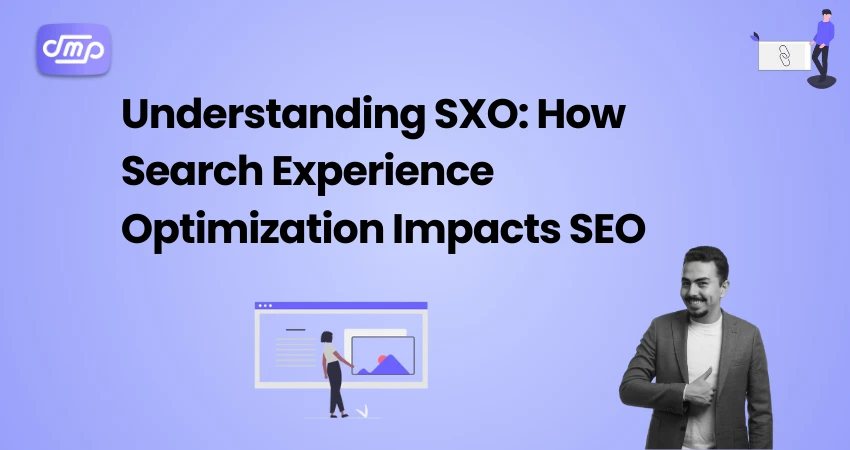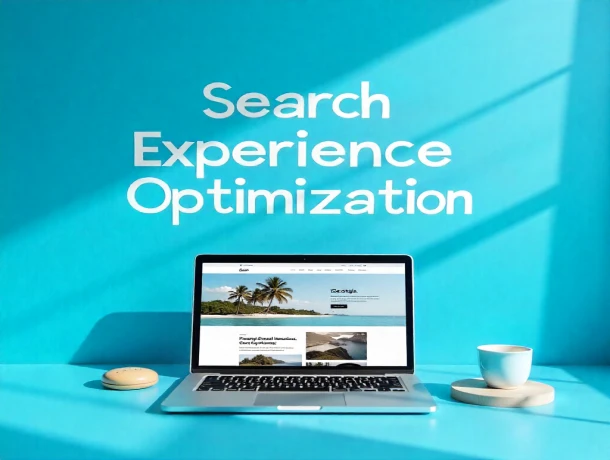
- August 18, 2025
- Digital Marketing, seo
- Digital Marketing
Table of Contents
The world of digital marketing is changing, and success today is more than merely ranking high in search engines. While SEO increases visibility, user experience affects whether visitors stay, interact, and convert. This is where understanding SXO (Search Experience Optimization) becomes critical. SXO blends standard SEO methods with user-centric design and content strategies to provide a smooth transition from search to conversion. Businesses that prioritize both search performance and user delight can achieve long-term growth in an increasingly competitive digital world.
What is SXO?
SXO (Search Experience Optimization) is an extension of SEO (Search Engine Optimization). While SEO primarily focuses on improving a website’s ranking in search engines, SXO takes it a step further by merging SEO with User Experience (UX) and Conversion Rate Optimization (CRO).
Simply said, understanding SXO ensures that when consumers encounter your website through search engines, they have a smooth, engaging, and rewarding experience that encourages them to remain, investigate, and take action.
Key Features of SXO
- Search Visibility entails ensuring that your website ranks well using strong SEO basics (keywords, structured data, and backlinks).
- Creating a website that is simple to use, fast to load, mobile-friendly, and visually beautiful.
- Relevance entails providing high-quality, intent-driven information that actually addresses user inquiries.
- Conversion Optimization (CRO) entails converting users into customers via clear CTAs, forms, and conversion funnels.
Why SXO Matters in Today’s Digital Landscape

The digital world has shifted drastically in the last decade. Search engines such as Google no longer reward websites that just stuff keywords or build links without adding any value. Instead, they reward websites that provide the best user experience—from search to action. This shift has made understanding SXO more vital than ever.
- Search engines are user-centric: Google’s algorithm changes, including RankBrain, BERT, and useful Content Update, are intended to better comprehend user intent and promote pages that give the most relevant, useful, and engaging results. Understanding SXO perfectly aligns with this strategy, guaranteeing that your content not only ranks but also meets user expectations.
- SEO is no longer enough: Traditional SEO can drive traffic to your website, but if people arrive on a slow, confused, or irrelevant page, they will leave within seconds. High bounce rates and low engagement have a detrimental influence on rankings. Understanding SXO bridges this gap by focusing on what happens after the click: increasing dwell time, click-through rate (CTR), and conversions.
- Users want seamless experiences: Modern users are impatient. They like fast-loading pages, simple navigation, mobile-friendly designs, and tailored information. SXO meets these needs by merging SEO methods with user experience concepts, guaranteeing that visitors discover value right away.
- Increases engagement and conversions: SXO is more than just ranking higher; it is about meeting business objectives. An SXO-optimized website keeps customers engaged with relevant content and intuitive design, directing them seamlessly to conversions such as purchasing, booking a service, or subscribing to a newsletter.
- Competitive advantage: Businesses who use SXO gain a significant competitive advantage in today’s saturated digital arena. While many businesses continue to rely solely on SEO, those who use SXO establish a lasting connection with consumers, enhancing both short-term performance (traffic and rankings) and long-term success (loyal customers and brand trust).
Key Elements of SXO

Search Experience Optimization (SXO) is a comprehensive strategy that combines SEO, user experience (UX), and conversion rate optimization (CRO). The following are the essential aspects that comprise SXO:
- On-page SEO Optimization: Create intriguing meta titles and descriptions to boost click-through rates (CTRs). Use structured data (schema markup) to create rich snippets and improve SERP exposure. Ensure that keyword placement feels natural, with an emphasis on user goal rather than ranking.
- Content Quality and Relevance: Create content that directly responds to user searches and corresponds to search intent.Maintain clarity, readability, and E-E-A-T (experience, expertise, authority, trustworthiness). Use visuals (infographics, films) to increase engagement.
- User experience (UX): Simple navigation and site layout for quick discovery. Responsive design ensures accessibility across all devices. Layouts that are clean and clutter-free help to lessen visitor friction.
- Page Speed and Mobile Optimization: Fast-loading pages are crucial since delays raise bounce rates.Optimize images, enable caching, and use a CDN for better performance. Because mobile devices account for the majority of searches, ensure that mobile-first indexing is supported.
- Conversion Rate Optimization (CRO): Place clear calls to action (CTAs) in important locations.To reduce drop-offs, streamline your forms and checkout processes.
- Trust and Security Signals: Use HTTPS/SSL certificates to ensure secure browsing. Display reviews, testimonials, and trust badges to increase trustworthiness. Maintain clear privacy rules and easy-to-find contact information.
- Analytics and Continuous Improvement: Google Analytics, Heatmaps, and Search Console are all tools for tracking user behavior.Analyze bounce rate, dwell time, and conversion paths to discover weak points. Continuously improve both SEO and UX techniques for long-term success.
How SXO Impacts SEO Performance
Search Experience Optimization (SXO) does not replace SEO; rather, it enhances it. By combining visibility and usability, SXO ensures that search traffic is more than just clicks; it is about meaningful engagement and conversions. Here’s how SXO directly influences SEO performance:
- Increased click-through rates (CTRs): Meta titles, descriptions, and rich snippets that are well-optimized are more likely to generate traffic. A greater CTR indicates to search engines that your page is valuable, which can improve rankings.
- Lower bounce rates: If consumers quickly leave your site due to poor design, irrelevant content, or slow loading times, SEO suffers.
- Longer Dwell Time: Quality information, simple navigation, and compelling visuals attract visitors to remain longer. Longer stay time informs search engines that your material is relevant, increasing your authority and visibility.
- Improved user engagement: Interactive elements such as movies, infographics, and FAQs increase on-page engagement.More engagement leads to higher user happiness, which is increasingly included into ranking algorithms.
- Improved Conversion Signals: Search engines track user behavior beyond the initial click. When people fulfill goals (sign-ups, purchases, and downloads), it demonstrates that your site is trustworthy and relevant, which indirectly improves SEO.
- Mobile-First Indexing Advantages: Because Google now prioritizes mobile-first indexing, a mobile-optimized SXO strategy promises greater rankings and increased user retention.
- Increased Brand Authority: SXO gains reputation by providing consistent and satisfactory user experiences. A trustworthy brand generates more backlinks, mentions, and return visitors—all of which are important SEO ranking factors.
Practical Strategies to Implement SXO
Understanding SXO aims to balance search visibility with user pleasure and conversions. To make it actionable, here are some practical tactics you may implement:
- Conduct keyword and intent research: Focus on understanding the user purpose behind searches and creating content that directly addresses their requirements.
- Optimize the Click-Through Rate (CTR): Create interesting meta titles and descriptions, and use structured data to increase clicks from search results.
- Improve site design and navigation: Ensure that your website has a clean structure, simple navigation, and an intuitive layout that leads users easily.
- Improve Page Speed and Mobile Experience: Provide fast-loading, mobile-friendly pages to reduce bounce rates and increase user satisfaction.
- Create high-quality, user-centric content: Create relevant, engaging, and well-structured material that meets user search intent and keeps them interested.
- Conversion Rate Optimization (CRO): Clear calls to action, simple forms, and friction-free landing pages can all help to increase conversions.
- Utilize analytics and user feedback: Use tools and feedback to better analyze user behavior, identify weak places, and continuously improve.
- Optimize for voice search and featured snippets: Adopt conversational content and concise replies that are consistent with modern search trends.
- Increase trust and credibility: Establish authority through secure browsing, testimonials, reviews, and transparent business information.
Conclusion
As search engines evolve, exposure is no longer sufficient to ensure success. Understanding SXO (Search Experience Optimization) entails looking beyond standard SEO and concentrating on how consumers interact with and experience your website, rather than just rankings. SXO ensures that your site attracts the proper audience, keeps them interested, and leads them seamlessly to conversion by combining SEO, UX, and CRO techniques.
Businesses that embrace SXO gain a competitive advantage by providing smooth, user-first experiences that search engines and visitors alike value. In today’s digital market, the future of SEO is to optimize the complete journey—from search inquiry to final click.











